Video Presentations
We will be adding Video Presentations. For now, we have the extremely informative presentation by the esteemed Dr. Rau.
We will be adding Video Presentations. For now, we have the extremely informative presentation by the esteemed Dr. Rau.
Explore advances and more accurate diagnostics.
Infrared Thermal Imaging (I.R. Camera Thermography) and Regulation Thermography in Medicine
Complementary & Non-Invasive Patient Assessment Tools - A Comparative Study
by Dr. Daniel Beilin, OMD, LA.c.
Abstract
Digital Infrared Thermal Imaging (DITI) uses an infrared (IR) camera with chip arrays that receive infrared photons emitted from the skin surface and converts them into electrical impulses. These impulses are then reconstructed as images to show individual heat patterns in different colors that are displayed for interpretation. The camera is typically placed directly in front of the patient and a picture is taken.
One shortcoming of this method involves the oblique aspects of the skin (e.g. side of the breast) which arrive at the camera at a different focal length interfering with wavelength interpretation that may therefore contribute to false positive and negative results. In addition, IR camera images require expert “human” interpretation which is inherently subjective that can result in missed or misinterpreted data further impacting accuracy.
Regulation Thermography uses a hand-held sensor equipped with a germanium crystal that filters the infrared photons. A thermocouple inside the sensor is specifically tuned to the temperature ranges of the human body. The sensor is held at precisely the same angle and distance from the skin for each of the 120 points measured, and the data is evaluated digitally thereby eliminating human subjectivity for increased accuracy. Sophisticated Internet-based ‘signature recognition’ software (an accumulation of 30 years of data that has been clinically corroborated through blood tests, imaging, and pathology find- ings), recognizes signature patterns of physiological disorders in nearly 40 categories.
The software not only identifies the disorder signature, but also indicates the severity of the fulfillment of that signature’s pattern criteria. These advances not only guide physicians in developing targeted treatment strategies, but also address the primary factors leading to false positives and negatives associated with medical thermography in general. Both Infrared Thermal Imaging and Regulation Thermography can play important roles in health assessment and treatment optimization.
Introduction
Medical thermography is a non-invasive, radiation-free physiological test that measures skin temperature and skin temperature differences at focused locations through the use of infrared chip arrays. It provides information that can help identify or clarify disease processes, and is considered an adjunct to conventional imaging tests such as X-Ray, mammography, ultrasound, and MRI.
Infrared Thermal Imaging (IR Camera method) records photon emissions from the skin at a distance of 1-3 meters, while Regulation Thermography (point-temperature measurement method) uses an infra- red, neurologically specific, controlled point, near-proximity (0.5 cm.) sensor that samples 120 points on the body surface and can provide deep tissue and organ information specific to the measured regions as conveyed through the sympathetic nervous system’s signals and response.
The primary objective of this paper is to illustrate that, while both methods are valuable and complementary, by adding Regulation Thermography it helps the physician to:
Infrared Thermal Imaging received FDA clearance in 1982. Since Thermal Imaging utilizes a camera that displays an image directly, it easily found a niche in radiological investigations when first introduced. Software improvements in the last 10 years have enhanced its ability to objectify patterns and resolve minute vascular changes, often reflective of angiogenic features of tumors. Interpretation by a trained “thermologist” is typically performed remotely, leading to the creation of a patient report.
Regulation Thermography received FDA clearance in 1997. It takes digitized single-point temperature measurements before and after whole-body expo- sure to a cool-air (room temperature) stimulus, that are then digitally analyzed - within 60 seconds - interpreting patterns of pre-and-post stress behav- ior. Measurements are captured and stored digitally and remain in digital form before being processed through defined computer algorithms. Over 30 years of “disease signature patterns” have been incorporated into ‘expert’ software, that serves as a clinically verified library of point behavior characteristics. A multi-page report (text & images) is generated immediately after the test is completed. Since Regulation Thermography relies primarily on the use of mathematically based signature recognition algorithms (1) (vs. graphical imaging), it’s more appropriate to refer to this science as “Regulation Thermometry” to better define its place as a comple- ment to Infrared Thermal Imaging. From this point forward we will refer to this method as Regulation Thermometry.
(1) Rost, A and Rost, J: Introduction to Regulation Thermography. Hippocrates Press, 1990
How Each Technology Works
Infrared Thermal Imaging uses an infrared camera chip-array to convert infrared radiation emissions into colorized pixels. A visual image, referred to as a thermogram, graphically maps vascular differences and changes using software to improve resolution, and provide potentially enhanced diagnostic information. For example, since there is a high degree of thermal symmetry in a healthy body, subtle temperature variations could be indicative of abnormal tissue changes and possible inflammatory or neoplastic conditions. Some camera methods call for the patient to undergo an autonomic response challenge by way of cold water exposure of the hands or whole-body cool air exposure ‘before and after’ imaging. This is referred to as dynamic thermography (a key feature of the Regulation Thermometry measurement process).
Regulation Thermometry utilizes the biological phenomena of nerve innervations from organs, glands, lymph, teeth & brain to the skin’s sub-cutaneous capillaries via the sympathetic nervous system’s spinal reflex-arc, thereby neurologi- cally accessing characteristics of the tissue and organ ‘regulation capacity’.
By measuring skin temperature and temperature changes before and after a cool stress, information can be gained from specific organ- influenced regions. The data is derived from the measurement and relational behavior of two sets of point measurements taken before and after the body is subjected to a 68-71°F (normal room temperature) exposure. The patterns of the point and region behavior are compared to a database of some 30,000 cases, utilizing and comparing data from proven ‘normal’ or ‘ideal’ point-temperature responses.
A graph of the temperature readings, referred to as a regulation thermogram, is included in a data-driven report that includes written and graphical portrayals of the various patterns or ‘signatures’. In addi- tion, deviations from the known ideal behaviors, both regionally and locally, are displayed by a synthesis-mapping of the behaviors onto a 2D colorized body image.
Because Regulation Thermometry provides insights into the internal biological terrain while analyzing and prioritizing reflections of organ dysfunction, it can help to clarify potential causal factors of many disease processes often years before symptoms become visible through imaging methods.. Although it is able to reveal hidden focal infections and metabolic abnormalities through physiological functional resolution, Regulation Thermometry is not a substitute for other anatomical resolution imaging methods, such as mammography, ultrasound, or infrared (IR) camera.
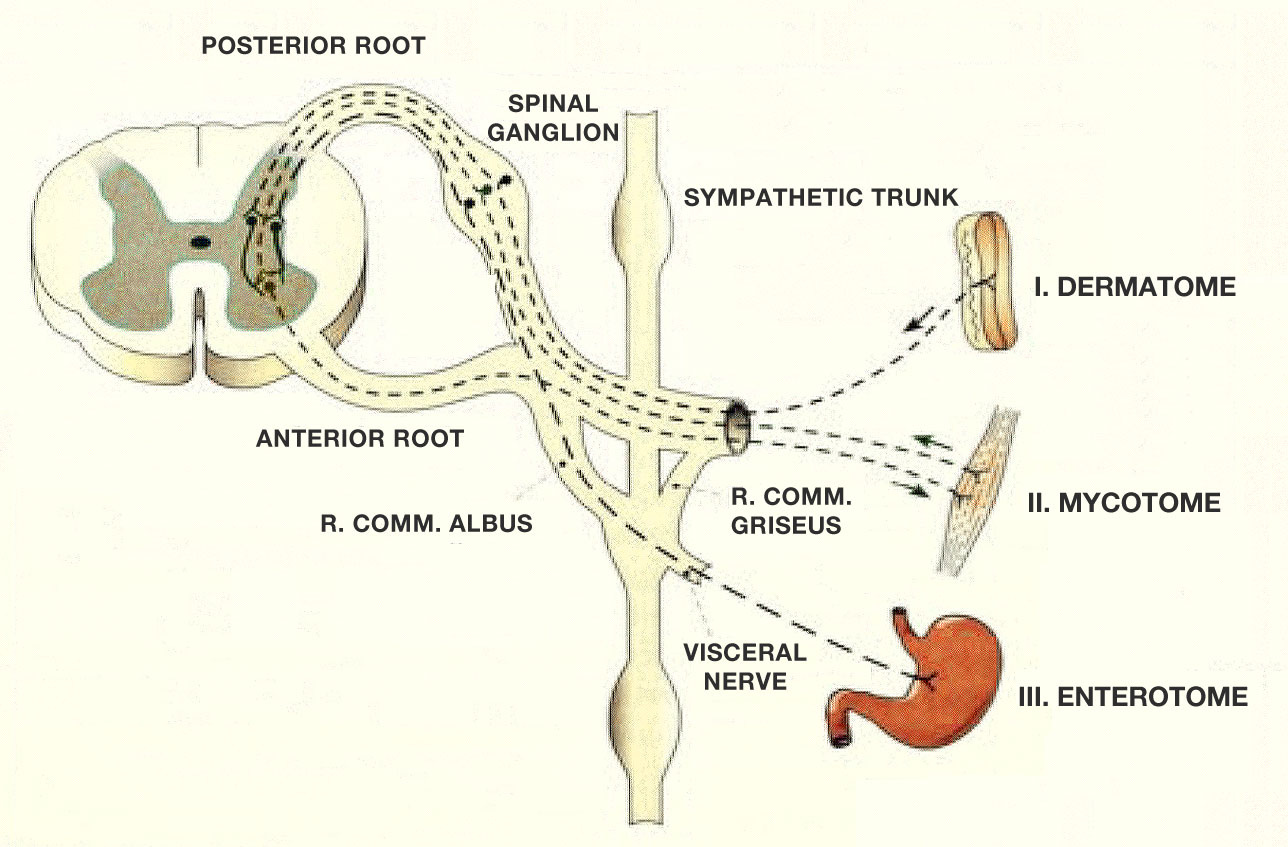
(modified after Hansen and Schliack):
I: Multisynaptic reflex from dermatome to myotome
II: Viscerogenic reflex from dermatome to enterotome
III: Viscerogenic reflex from enterotome to myotome
Case Study: 60 Year Old Female with Possible DCIS and Viral Presence
A 6o-year old female with a family history of breast cancer and a personal history of skin cancer (basal cell carcinoma.) presents at the clinic with a set of sequential Infrared Camera breast images evaluated to reflect a minor risk for malignant dis- ease (TH-3F). Two hyperthermic (hot) spots appear on each breast, indicative of probable acute hyper-metabolic activity or a mammary duct infection (Exhibit 1). She was advised to return for a third test in 6 months for further clarification of risk category.
The patient was anxious about the prospects of further aggressive diagnostic procedures such as biopsy, contrast MRI, etc. She was also seeking recommendations for proactive steps she could take to address the findings, since the image resolu- tion of the abnormality in temperature characteristics was not significant enough to determine a definitive course of appropriate action. The IR camera consultation suggested possible DCIS and a viral presence, but with no further direction for therapeutic intervention. Status was clearly stable and not indicative of a progressive disorder. Although the IR Camera method was able to show diminished risk, the data set was unable to identify any deeper causal and/or related surrounding dysfunctions. This is a clear example of where anatomical resolution revealed abnormalities, but without functional resolu- tion to reveal the surrounding influences and physiological dynamics, a treatment strategy could not be determined.

The patient’s anxiety level was elevated, potentially influencing the matrix physiology and a more ‘vulnerable’ terrain, and possibly creating a hyper-activated sympathetic compensation that may or may not have aided a pathogenic process. If, for instance, triggering mechanisms such as chemical exposure or prolonged tissue acidosis were present, circulating tumor cells could find a focal point for neoplastic activity and formation.
A Regulation Thermometry test was performed to help alleviate the patient’s anxiety by presenting a new system-wide perspective. Regulation Thermometry helped to confirm the Infrared Camera results, identify potential causal factors, aid in outlining treatment strategies, and determine if more extensive testing was necessary.
Details of the Case Study
Breast points were sampled before and after a cool-air stress was applied to the whole body. The before and after tem- perature measurements appearing on the accompanying graph are color coded to facilitate accurate point behavior assessment by the practitioner, and thereby help to eliminate subjective conclusions. (Exhibit 2).
 In this particular case, most points were hyper-regulating, which is a pattern con- sistent with a toxic burden to the tissue, often present in DCIS. The breasts were symmetrical (same temperature) and there was a mild temperature increase at the same areas identified by the Infrared Camera method. This is indicated by appearance of the first measurement values above the 34.5°C baseline (Exhibit 2).
In this particular case, most points were hyper-regulating, which is a pattern con- sistent with a toxic burden to the tissue, often present in DCIS. The breasts were symmetrical (same temperature) and there was a mild temperature increase at the same areas identified by the Infrared Camera method. This is indicated by appearance of the first measurement values above the 34.5°C baseline (Exhibit 2).
Normally the first measurement values should always be below the baseline. In addition to symmetrical assessment and identification of hot spots, Regulation Thermometry’s intelligent software objectively qualifies other abnormalities in the thermogram to reveal an entire picture that enables the physician to properly stage the patient and address underlying problems in an intelligent manner.
A reconstructed visual synthesis of the point behavior helps communicate additional information.
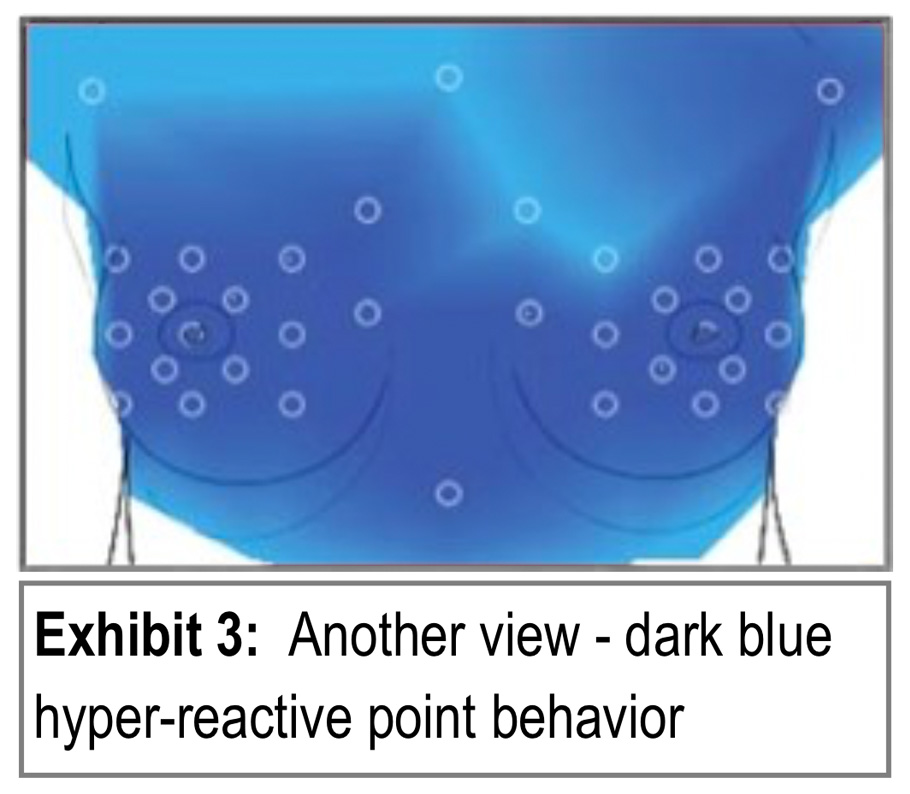 Here, in Exhibit 3, the behavior of the points (mostly hyper-reactive, becoming too cold during a normal stress exposure) appear dark-blue, instead of the normal/ideal light blue.
Here, in Exhibit 3, the behavior of the points (mostly hyper-reactive, becoming too cold during a normal stress exposure) appear dark-blue, instead of the normal/ideal light blue.
Next, criteria contributing to possible pathology are constructed from established algorithms and 30 years of cumulative breast cancer patient data.
Here, in Exhibit 4, only 2 of 12 abnormal breast criteria (factors) are met.
One is a lymph-involvement (Tonsil-Lymph block) and the other is a breast disorder ‘index’ elevation (Breast disorder elevated) - representing deviations from more consistent point behavior within all breast measurement points.

Regulation Thermometry provides a multi-dimensional interface for the physician. Not only can signa- tures for disordered physiology be resolved, but the severity of those signature-disorders is analyzed as well. This can provide the basis for creation of a strategic ‘map’ that physicians can use to prioritize appropriate treatment protocols.
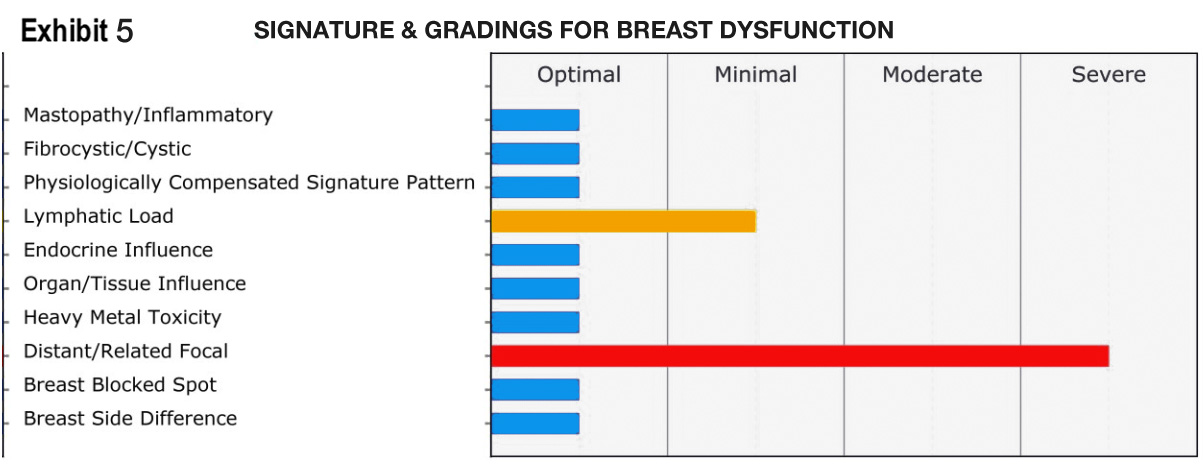
Exhibit 5 reveals, two positively identified patterns, one severe and the other minimal. The severe pattern is identified as ‘distant related focal’ and refers to the possibility that a distant focal infection is at the root of the local breast inflammation. The IR camera technology reported a potential ‘viral presence’ but did not identify the nature or source of the infection.
Distant Focal Infection: Dental Analysis Using Regulation Thermometry
Referring back to the regulation thermometry report we find a right side tonsillar block on the graph (Exhibit 6A) and a breast-related tooth in the dental analysis (Exhibit 7B) was identified by the regulation thermometry data, shown below:
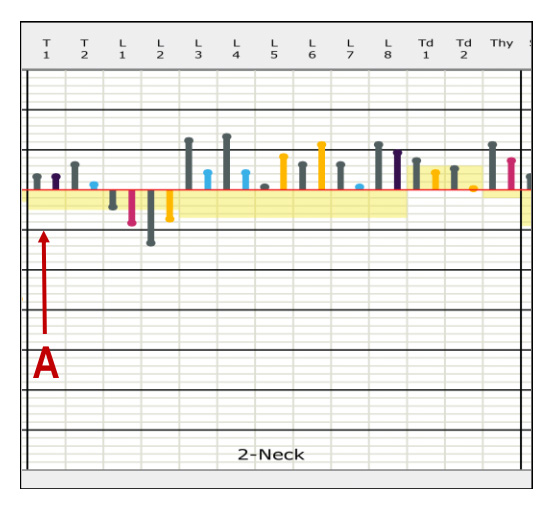
Exhibit 6 (A)
In the neck region, four points can be said to reflect possible physiological dysfunction or reaction response that are related to the tonsils.
Here, the first point (right inframandibular) does not reflect any reaction (cooling or heating) and therefore may be reflective of a latent infection that is inhibiting the conduction of the normal excitation of the sympathetic vaso-constriction that is normally seen in healthy patients.
This may be a factor that could easily be overlooked by other non-physiological or whole-body approaches.


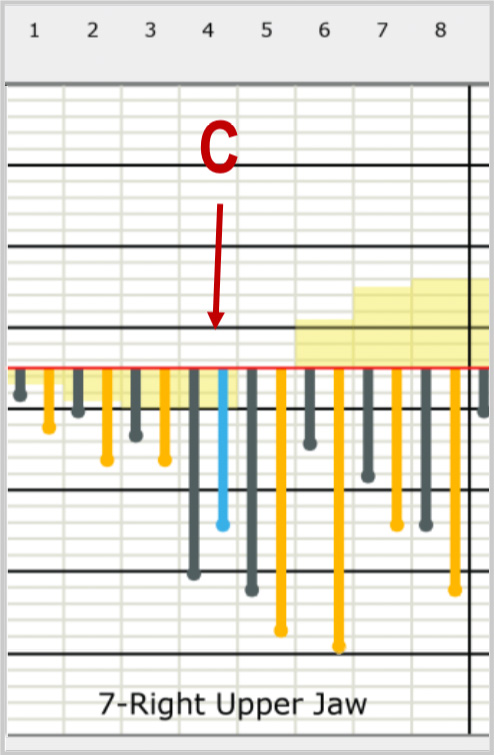 Exhibit 7 (B & C)
Exhibit 7 (B & C)
In the dental thermogram, teeth that are proximal to each other and have differing behaviors or tempera- tures than their neighboring teeth can be reflective of periodontal or microbial infections and problems. Here, tooth 4 behaves in an OPPOSITE way than its neighbors (C) and is identified with a ‘speckled’ appearance (B).
As a general guideline, if a tooth has connections to the organ in question through the neurological or meridian systems in Chinese Medicine, one can build the case for further investigation into this distal influence. In this case, tooth 4 connects with the right breast.
Empowered with this causal information, a subsequent dental X-ray led to discovery of an abscess surrounding a faulty root canal. The patient received treatment and the infected tooth was addressed. Many treatment methods often fail when there is a hidden infection localized to the sinuses, teeth, ovaries, prostate, appendix or intestines.
A Brief Discussion of Accuracy
Infrared Camera Thermal Imaging: Accuracy can be affected by varying camera distances and oblique angles to skin- surface. Evaluation is based upon color gradients processed from a camera with a typical accuracy of +/-2% with a reso- lution sensitivity of .01 - .10°C. Though lateral views help to alleviate this oblique distortion, improvements could be made by creating a sweeping panoramic view that continuously records data from various angles. Accuracy is also dependent on the skill and knowledge of the interpreter (thermologist). Many IR Camera training programs are sufficient, however the inherent subjectivity and potential for human bias remains. In addition, a dynamic IR camera thermogra- phy method frequently used requires hand-immersion into ice water. This method has been proven to vary from per- son to person, therefore rendering the dynamic information unreliable.
IR Camera optical resolution is excellent. However, the adjunct diagnostic value of the final output differs between infrared cameras. Cameras that incorporate calibration between the chips in the IR chip array are more accurate than the majority of cameras available in North America. Resolution specifications do not necessarily mean greater accuracy. Chip arrays that are calibrated to the human body and between themselves (currently offered by only one or two manufacturers) are far superior even at lower resolutions (320 x 240) than high resolution non-inter-calibrated chip-arrayed cameras. Unfortunately, some infrared cameras being used for human breast assessment are industrial-grade versus medical grade, contributing to false positive and false negative results.
Conclusion
As this case demonstrates, both Infrared Camera thermography and Regulation Thermometry have their place in investigative medicine. Optical resolution (camera method) visualizes surface areas and allows surveillance of vascular phenomena parallel to neoplastic appearance and development. Informational resolution (Regulation Thermometry) utilizes verified patterns of body regions connected through neurological mechanisms and physiology that pertain to development and concurrent factors involved in degenerative diseases.
More About Regulation Thermometry ...
Direct skin surface temperature measurement results in increased accuracy by maintaining both exact diameter and distance to the skin and perpendicularity to the skin surface. Evaluation is based on numerical temperature change measurements with a precision of +/- 0.4 % with a resolution sensitivity of .01-.05° C. Computerized interpretation of dynamic digital values, utilizing 30 years of clinically verified empirical results, reducing subjectivity and the potential for human bias in interpretation. Pattern recognition algorithms aid the physician in consistent identification of abnormali- ties. Server-side software is continuously updated to take full advantage of ongoing research. Cooling is performed by passive exposure to ambient air, a method proven to be valid and independent of individual dynamics.
TESTING PROCEDURES
Infrared Thermal Imaging: Room Temperature Requirement: Between 18° and 22° C. (64.4° to 71.6° F)
Typical Scanning Procedure: Patient spends 5-10 minutes undressed to the waist to cool breasts to room tempera- ture, then sits on a stool located 3-7 feet from the camera. The hands are held behind the head while a trained technician takes several images.
Test Results: Thermal scans are sent to an interpretation service where they are read by certified thermologists. Interpreters use software to compare temperature changes in various ways:
breast comparison, side-to-side
in specific areas such as part of a breast
A patient report is typically available 1 to 7 days after the scan, depending upon the service, and can be expedited for an additional fee.
Regulation Thermometry: Room Temperature Requirement: Between 19.5° - 22°C (67° – 72° F)
First Measurements: Patient stands and gradually disrobes as a trained technician uses the infrared probe to take the first temperature measurements at 120 points on the body, including breast and teeth.
10 Minute Cooling Period: The patient stands disrobed to their underwear to initiate the autonomic response to the cold stimulus before the second measurements are taken.
Second Measurements: The 120 temperature measurements are repeated.
Test Results: The system software graphs the temperature readings in pairs consisting of first and second readings for each point. This data is then sent via secure internet connection to a central server where a fuzzy-logic computerized analysis identifies patterns of dysfunction that, through extensive clinical research, have been associated with disorders and disease processes. A multi-page text and image report is available immediately after a 30-minute test procedure.
Patient Reports
Infrared Thermal Imaging: A report consisting of the thermographic images and a written interpretation by a certified thermologist.
Primary Market: As an adjunct diagnostic method for women concerned about breast health. It is also commonly used by sports physicians and veterinarians to determine areas of the body that have inflammation.
Report Availability: Between 1 to 7 days after the scan, depending upon the service, and can be expedited for an additional fee.
Regulation Thermometry: The system software provides a comprehensive evaluation of the patient’s physiological health with indications of potential or existing disease processes at various neurologically represented stages of devel- opment. A detailed 7-page text and image report includes ratings and priorities for over 60 signature patterns of disease processes, 2D breast and full-body images of the functional results synthesized from point behavior changes, as well as integrative breast (12 criteria), prostate (9 criteria), and dental analyses.
Primary Market: As an adjunct diagnostic tool for women, men and children, to identify the root cause of existing dysfunction, or as a preventative test to identify sub-clinical disturbances before they become problematic.
Report Availability: Within one minute after the scan, internet/software driven, utilizing established algorithms.
Cost
Digital Infrared Thermal Imaging (DITI):
System: $18,000 - $80,000 ... depending on camera, resolution, software, and training
Reports: Breast Only $75, Half-Body $125, Full Body $175
Regulation Thermometry:
System: $17,000, includes all hardware, software, upgrades, training, tech support & customer service.
Reports: Whole Body $35-$45 (packages can reduce cost).
Training
Infrared Camera Thermal Imaging:
2-Day level 1 Technician Training at a training facility. Level 2; Level 3 training & certification also available.
Certified Thermologist training and certification for report interpretation also available for a fee.
Regulation Thermometry:
Technician training conducted via on-line meeting technology and webcams during 2, 2-hour sessions and repeated as required. User manuals and on-line video tutorials are also available.
Report analysis training for physicians conducted via weekly case review webinars. User manuals, on-line video tutorials, and a video case library are also available. Continuing education in Biological and Functional Medicine.
Technical Support
Infrared Thermal Imaging: Free, live technical support and remote help desk.
Regulation Thermometry: Free, live technical support.
Reference Information
Rost, A. and Rost, J.: Introduction to Regulation Thermography. Hippocrates Press, 1990
Blum, P.: Regulationsthermographie. Hippocrates Press, 1997
Odell, J.: Introduction to Regulation Thermography. 2010
Gautherie, M.: Thermobiological Assessment of Benign and Malignant Breast Diseases. American Journal Obstetrics & Gynecology. 8 (147) 861-869 1831
Nyirjest I, Ayme Y, et.al.: Clinical Evaluation of Mammography and Thermography in the Diagnosis of Breast Carcinoma Thermology 1: 170-3 1986
Results and Conclusions of the International Thermography and Regulation Medicine Conference, Frankfurt Germany, 2014: Reinhold Berz, MD, Chair
DOWNLOAD THE IR vs RT Article PDF
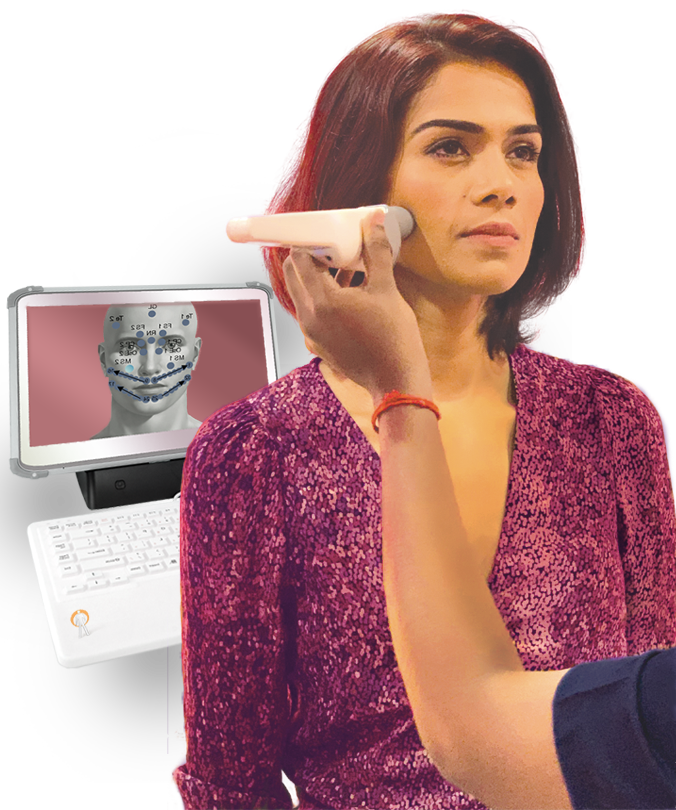 At Alfa, our goal is to revolutionize it.
At Alfa, our goal is to revolutionize it.In order to create true health, one needs to see trends in physiological function before they manifest into pathology.
To do this, practitioners must have:
The Alfasight simplifies both of these points, and more.
For example, it can help you easily determine whether a variety of health issues stem from a Dental or Systemic/Organ cause.


Dental - Caused Rheumatoid Disease
Single deviant teeth point to dental cause.
Validation of Acupuncture Meridian System.

Organ - Caused Dental Projections
Liver block projecting to liver-related teeth.
Multiple Liver-related teeth point to Systemic cause.
With pathology (cellular/metabolic disease) there are always contributing, parallel systems involved to summate an overall diagnostic criteria. These multiple systemic contributing factors are easily seen by way of the AlfaSight 9000 technology.
The AlfaSight can indirectly SEE those influences since their signals are sent through the sympathetic nerves and reflect in the dynamic changes in skin temperature within their own neurological projection zones (Head Zones were clearly mapped by the famous English neurologist Henry Head).
Finally, scientific, reproducible and neurologically-based physiological medicine at your fingertips, all NON-invasive, 20 minutes, with instantaneous reporting (6 page report).
View a breast cancer patient’s results.
Discuss training & purchase options with Dr. Daniel Beilin
You can clearly identify contributing factors thus aiding in strategies to obtain maximized progress towards health.
Sales Team +1 (866) 652-6600 x2, or
Dr. Beilin +1 (866) 652-6600 x1
For International callers +1 (831) 245-0588.
The AlfaSight 9000 is a clear revenue-generating workstation. You could be away on vacation while your office schedules up to 8 thermo tests per day, equivalent to around $2000+ per day, - and when you return, you have a complete reflection of the dynamics of each patient’s individualized health, thus enabling immediate strategizing or follow-on tests that are directed at the most crucial imbalances.
You don’t waste time chasing a disease to its cause over months or even years.
You KNOW IT with the FIRST 20-minute scan.
Comparison Table of Regulation Thermometry (AlfaSight) with Conventional Assessment Methods © Dr. Daniel Beilin, 2018
|
Technology |
AlfaSight 9000 Thermography |
IR Thermography (Camera method) |
Ultrasound |
Comp.Tomography (CT) |
MRI |
X-Ray (Mammography) |
|
How it Works |
Uses Infrared sensor. Temperature measurement window (germanium crystal) measures skin temperature: accuracy: +/- 0.1 degree C. Analysis software provides for documentation and data accumulation. Easy to train and use graphics and synthesis of body image according to functional physiology. Also utilization for treatment outcome monitoring. |
Uses an infrared camera. Liquid crystals and IR cameras provide a color image of heat distribution that is converted into temperature values. Documentation is made with the images formed. |
High frequency sound waves bounced off the tissue and collected as an echo to produce an image |
Uses X-Ray. Creates a series of horizontal cross-sectional images of the body. |
Uses magnetic field and radio frequency to produce cross-sectional, three-dimensional images from different angles inside the body. |
Radiation transmission through tissue to produce an image. Suspicion can be seen with hyper-densities |
|
Visualization Method |
Functional imaging. Detects physiological change with specified location/organ involvement. Procedure time: 20 minutes |
Functional imaging. Adjunct diagnostics, detects physiological changes. Procedure time: 20-30 minutes. |
Structural imaging. Ability to locate the area of suspicious tissue. Procedure time: 20-45 min. |
Structural Imaging. Ability to locate the area of suspicious tissue. Procedure time: 30-120 min. |
Functional and structural imaging. Ability to locate the area of suspicious tissue. Procedure time: 15-45 min. Longer for detailed studies. |
Structural Imaging. Ability to locate suspicious tissue. Procedure time: 10-20 minutes. |
|
Invasivity/Risk |
No radiation, non-invasive, harmless |
No-radiation, non-invasive, harmless |
No radiation. In most cases, non-invasive. Can be harmless. A gel is applied to the region to assist the transmission of sound waves |
Iodine-based contrast infusion, different than MRI media, may be necessary to enhance image. Allergic reactions are rare but occur, toxicity possible. |
No radiation. A dye-media infused often necessary. Allergic reactions possible but rare. Dye-contrast contains heavy metal found possibly toxic long term. |
Exposure to radiation may predispose one to cancer. |
|
Diagnostic Use |
Earliest method of cancer detection known (breast). Adds to information regarding causes and coincident organ involvement in many disorders/diseases |
Used to complement mammography |
Not a screening procedure. Often used to investigate an area already detected by physical exam, mammography or other imaging method. |
Not a screening procedure. Used to investigate an area already detected by other imaging or tests. |
Can be used as a screening procedure, can replace mammography. |
Can detect cancers earlier than physical examination. |
|
Diagnostic Error Subjectivity/Objectivity |
Mathematical Disease Signature Recognition removes subjectivity and decreases error |
Subjectivity causes higher error and discrepancy between thermographers |
Subjectivity dependent on training and technician/ procedure |
Radiologist-dependent |
Radiologist-dependent |
Radiologist-dependent |
|
Technology |
AlfaSight IR2-T Thermography |
IR Thermography (Camera method) |
Ultrasound |
Comp.Tomography (CT) |
MRI |
X-Ray (Mammography) |
|
Goal of Technology with ‘Evidence’ |
Detects asymptomatic (hidden factor) patterns that have lead to disorder, either before or coincident. Can be repeated to monitor protocol/treatment efficacy, and long term, monitor breast and overall health as an ongoing strategy in prevention |
Cancers are not detected before a tumor appears (area still appears normal on infrared). Can be used as often as indicated to trace a problem, observe the effectiveness of treatment, or monitor the temperature of the breast (or region) over time |
Detects only when growth/abnormality is 1-2 cm. |
Detects only when growth/abnormality is 1-2 cm. |
Detects only when growth/abnormality is 1-2 cm. |
Detects only when growth/abnormality is 1-2 cm. |
|
Diagnostic Ability/Limitations |
Findings increase suspicion category. Cannot directly diagnose. Defines recognizable patterns of disease and specifies abnormalities of the stress-response (regulation capacity), often before a disease manifests or becomes clinically overt. |
Findings increase suspicion. Cannot diagnose cancer. Used to diagnose the manifestation of a disease. |
Findings increase suspicion. Cannot diagnose cancer. |
Findings increase suspicion. Cannot diagnose cancer. Used to diagnose disease or the manifestation of disease. |
Findings increase suspicion. Cannot diagnose cancer but resolution high. |
Findings increase suspicion. Cannot diagnose cancer. |
|
Referrent Clinical Confirmation necessary? |
Biopsy, other imaging or clinical laboratory testing is necessary for clinical decision making, but precision-guidance for choices in follow-on tests are then made streamlined |
Biopsy is the only test that can determine if a suspected tissue area is cancerous |
Biopsy is the only test that can determine if a suspected tissue region is cancerous |
Biopsy is the only test that can determine if a suspected tissue is cancerous |
Biopsy is the only test that can determine if a suspected tissue area is cancerous. |
Biopsy is the only test that can determine if a suspected tissue is cancerous |
|
Accuracy (Positive) |
Can detect breast and other pathologies up to 5 years before a tumor may be identified by other methods. Increases the certainty of diagnosis by quantifying and qualifying the cutaneo-visceral reflex reflection of tissue abnormality. Can detect fast-growing aggressive tumors. A positive identification of abnormal regulation response has been determined to predict breast disease as the highest accuracy amongst other imaging methods. INFORMATIONAL RESOLUTION provides objective data only. |
Due to the nature of infrared imaging, precancerous and cancerous tumors as deep as the chest wall can be detected. However, most IR Cameras are not intended for human use and are not properly calibrated to the human organism. |
Ability to detect some cancers missed by mammography. Good at distinguishing solid masses from fluid-filled cysts |
Provides accurate images in the location and size of a tumor. |
Provides accurate images in the locations and size of a tumor. |
Can detect tumors in the pre-invasive stage in mainly slow-growing cancers. |
|
Technology |
AlfaSight IR2-T Thermography |
IR Thermography (Camera method) |
Ultrasound |
Comp.Tomography (CT) |
MRI |
X-Ray (Mammography) |
|
Accuracy (Negative) |
May miss certain tumors in the abdomen or pelvis. |
May not detect some slow-growing, non-aggressive cancers. Many false positives or borderline statements create patient panic. Difficult to discern. |
Many cancers are not visible and in some cases, ultrasound is not able to detect whether a mass is cancerous |
Motion lessens the resolution/quality of the image. Metal objects may block views. |
Cannot distinguish between cancer and benign breast disease. Better than CT for viewing soft tissue. |
Cannot detect exponentially fast growing tumors in the pre-invasive stages. In most women, the medial upper triangle, peripheral areas next to the chest wall, and the inflammatory sulcus cannot be visualized |
|
Region(s) Visualized |
All areas visualized |
All areas visualized |
All areas visualized |
All areas visualized |
All areas visualized |
All areas visualized |
|
Sensitivity |
Average 90% sensitivity (10% of cancers missed) in all age groups. Of the missed cancers, majority are slow-growing and poorly invasive. |
Measures temperature and heat radiation. Resulting thermograms have to be interpreted subjectively. May be sensitive to non-tumorous vascular nuances and provide inaccurate assessment. |
Average 83% sensitivity (17% of all cancers missed, all age groups) |
Avg. 63% (37% of all cancers missed) in all age groups. |
Avg. 90% sensitivity (10% of all cancers missed) in all age groups. |
Average 80% sensitivity (20% cancers missed) in women over age 50. Sensitivity drops to 60% in women under age 50 |
|
Sensitivity Interferences |
Poor control of room temperature (cold or warm), drug suppressions or other prior patient activities affecting autonomic regulation. |
Average 90% sensitivity (10% cancers missed) in all age groups |
None. |
Pregnancy, inability to lie still and metal objects may prevent a person from having a CT scan |
Some surgical implants, metal surgical clips or implants/plates or a pacemaker prevents a patient from having test. |
Hormone use decreases sensitivity |
|
Specificity |
Average 90% specificity (10% false-positives) due to thermography’s ability to act as an early-warning signal. |
Average 90% specificity (10% false positives) |
Avg. 66% specificity (34% false positives) |
Avg. 96% specificity (4% false positives) |
Avg. 88% specificity (12% false-positives) |
Avg. 75% Specificity (25% false positives). 85% of all mammography initiated biopsies are negative |
|
Specificity Interferences |
Poor control of room temperature (cold or warm), drug suppressions or other prior patient activities affecting autonomic regulation. |
none |
none |
Motion lessens quality of the image. |
none |
Large, dense and fibrocystic breasts cause reading difficulties |